In the Loire Valley
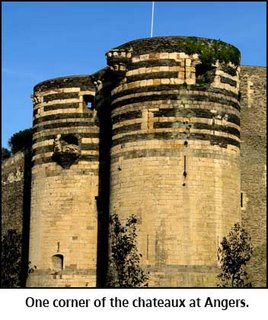
The week that included the 1st of November (Toussaint or All Souls’ Day) was a school holiday period here in France. Most of our regular activities (French class, chorus practice) were suspended, so we decided to go on a short trip. The lower Loire Valley was our destination. We headed first to Angers, seat of the dukes of Anjou and a western bastion for the kings of France in the period when Brittany was a separate kingdom.
The impressive château at Angers was built in the 13th century by Blanche of Castille, mother of King Louis IX, later recognized as Saint Louis. My grasp of
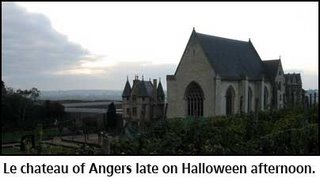 French history prior to the 18th century remains quite feeble, so I can’t expand upon the role played by Angers in the 100 years war between England and France and in the wars of religion between Catholics and Protestants in the 16th century. The château occupies a commanding position on a bluff overlooking the River Maine, which joins the Loire just south of the city. The round towers of the château once were 30 feet taller and capped by conical roofs. When improvements in artillery made these vulnerable, the towers were reduced in height.
French history prior to the 18th century remains quite feeble, so I can’t expand upon the role played by Angers in the 100 years war between England and France and in the wars of religion between Catholics and Protestants in the 16th century. The château occupies a commanding position on a bluff overlooking the River Maine, which joins the Loire just south of the city. The round towers of the château once were 30 feet taller and capped by conical roofs. When improvements in artillery made these vulnerable, the towers were reduced in height.We reached Angers late in the afternoon, with storm clouds moving away and providing a dramatic backdrop to the château. It was a treat to walk along the ramparts of the castle and look to the horizon, Aside from its architecture and history, the château is world-renowned as the home of the Tenture de l’Apocalypse (1370s), probably the most magnificent tapestry to
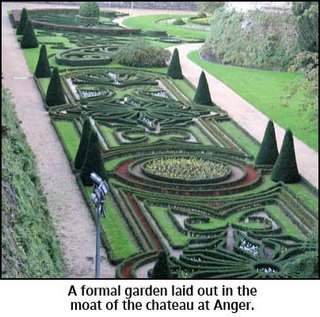 survive from the late Middle Ages. Containing 76 scenes and longer than a football field, the tapestry illustrates the imagery of the Book of Revelations very dramatically, with the four horsemen of the Apocalypse, the Anti-Christ as a beast with seven heads, etc. The city of Angers has an older core with some half-timbered houses and narrow streets. We left the next morning wishing we had longer to explore the city.
survive from the late Middle Ages. Containing 76 scenes and longer than a football field, the tapestry illustrates the imagery of the Book of Revelations very dramatically, with the four horsemen of the Apocalypse, the Anti-Christ as a beast with seven heads, etc. The city of Angers has an older core with some half-timbered houses and narrow streets. We left the next morning wishing we had longer to explore the city. 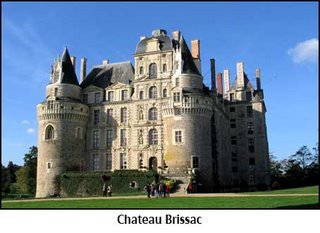
Near Angers is the Château de Brissac, a curious melange of medieval and Renaissance architecture. Two towers from the original 15th century fortress remain, while the rest of the building was completely redone around 1600. The lord of the manor had every intention of removing the two remaining corner towers, but h
 e died in 1621, leaving the abrupt transition between the two styles. The château rises 150 feet above a lovely park in the British landscape style. The family that has been in possession of the chateau for several centuries still lives there.
e died in 1621, leaving the abrupt transition between the two styles. The château rises 150 feet above a lovely park in the British landscape style. The family that has been in possession of the chateau for several centuries still lives there.The Brissac estate includes vineyards, and rosé and red wines are produced. Brissac lies within the Anjou-Saumur region, known for its rosés, whites made from the chenin blanc grape, and reds in which the tannic cabernet franc predominates.
From Brissac we headed west down the Loire to the Châreau de Serrant, an elegant home begun in the 16th century. The place is still occupied every summer for two months, but is also open for tours. The château is a very balanced composition of white stone, surrounded by a moat, and fronting on a formal allée. Brissac is known for its collection of furniture and a fabulous library of 12,000 volumes. Given my project cataloging the library at Kerivon, I was itching to stay behind and explore Serrant’s treasures, which include the first edition of Diderot a
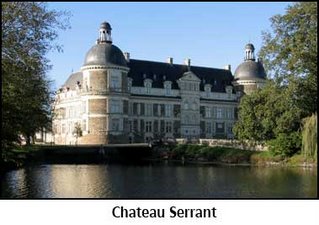 nd d’Alembert’s encyclopedia and the mammoth volumes of engravings of pyramids and temples produced by the scholars who accompanied Napoleon on his ill-fated invasion of Egypt (1798 to 1801).
nd d’Alembert’s encyclopedia and the mammoth volumes of engravings of pyramids and temples produced by the scholars who accompanied Napoleon on his ill-fated invasion of Egypt (1798 to 1801).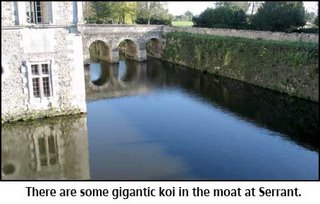
Two châteaux tours in one day being quite adequate, we continued along the Loire toward Nantes. We stopped in the town of le Marillais to look at a cemetery in all in its Toussaint splendor. The custom is for families to clean gravesites and adorn them with flowers, mostly mums. Mums are so indelibly associated with Toussaint that it is considered very bad form to bring 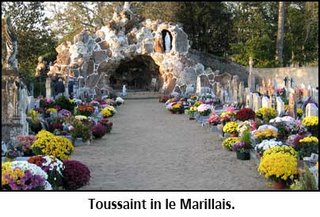 them as a host/hostess gift. There seems to be an element of competition in the drive to decorate the graves. The whole town turns out to observe who is (and isn’t) doing right by their departed relatives. The small cemetery at le Marillais, with its grotto at the back, was a memorable sight.
them as a host/hostess gift. There seems to be an element of competition in the drive to decorate the graves. The whole town turns out to observe who is (and isn’t) doing right by their departed relatives. The small cemetery at le Marillais, with its grotto at the back, was a memorable sight.
Nantes formerly was a bustling port and remains a metro area of some 600,000 people. We were especially interested in two museums there. Jules Verne grew up in the city, and there is a small museum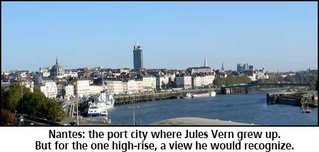 devoted to him in a 19th century house overlooking the Loire. All the biographies state that Verne was entranced by the ships and cargoes that arrived in Nantes from around the globe and was thus inspired to create his long series of fantastic voyages. The museum was instructive and fun. I was most entertained by some of the posters for movies made from Verne’s novels. Vincent Price wasn’t in all of them, it only seemed that he was.
devoted to him in a 19th century house overlooking the Loire. All the biographies state that Verne was entranced by the ships and cargoes that arrived in Nantes from around the globe and was thus inspired to create his long series of fantastic voyages. The museum was instructive and fun. I was most entertained by some of the posters for movies made from Verne’s novels. Vincent Price wasn’t in all of them, it only seemed that he was. 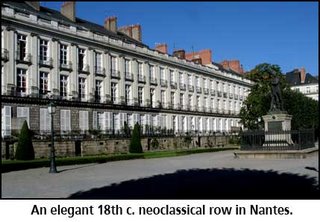
Nantes also has an impressive museum of printing, which again meshes quite nicely with my work at Kerivon. We took a tour with a bunch of kids and got to see a lot of old equipment in use. The linotype is a machine I have often read about, but now I have seen one in operation, with its pot of molten lead at the ready to cast lines of type. A flat-bed, screw-type press was also in operation, a machine that changed remarkably little from Gutenberg’s day (1450s) to the early 1800s.
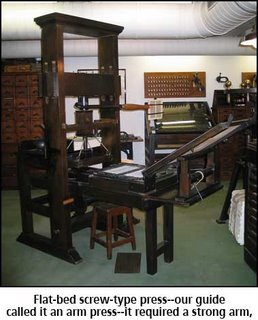
We planned our trip so as to be in Rennes, two hours from home, on Friday afternoon. We had to go to Rennes to submit to physical exams, one of the final steps in the arduous process of getting our cartes de séjour (French equivalent of green cards). The main concern seemed to be that we not be bringing TB into France (there was no HIV test). We passed our exams and have now paid 220 Euros each (on top of the $150 each we paid to apply for our visas in Atlanta), and after a mere seven months, seem on the verge of getting our cartes. By contrast, when an automated radar machine caught us speeding in October, it took only four days for the ticket to show up in the mail!
We were warned about the French bureaucracy, and it has lived up to its reputation. Everyone is very cheerful and smiling when they tell us that we will just have to wait, that they only have 7 of the 8 immigration stamps that we are required to buy, or that “the office in St. Brieuc is really swamped with applications.” I see all around me evidence that the French economy is inefficient and that the bureaucracy is bloated and unresponsive. The great majority of middle-class French people that I meet, though, seem not at all perturbed by the status quo. I imagine that feelings among the 9 percent who are (officially) unemployed and the youth of the immigrant suburbs are quite different.
 them as a host/hostess gift. There seems to be an element of competition in the drive to decorate the graves. The whole town turns out to observe who is (and isn’t) doing right by their departed relatives. The small cemetery at le Marillais, with its grotto at the back, was a memorable sight.
them as a host/hostess gift. There seems to be an element of competition in the drive to decorate the graves. The whole town turns out to observe who is (and isn’t) doing right by their departed relatives. The small cemetery at le Marillais, with its grotto at the back, was a memorable sight.Nantes formerly was a bustling port and remains a metro area of some 600,000 people. We were especially interested in two museums there. Jules Verne grew up in the city, and there is a small museum
 devoted to him in a 19th century house overlooking the Loire. All the biographies state that Verne was entranced by the ships and cargoes that arrived in Nantes from around the globe and was thus inspired to create his long series of fantastic voyages. The museum was instructive and fun. I was most entertained by some of the posters for movies made from Verne’s novels. Vincent Price wasn’t in all of them, it only seemed that he was.
devoted to him in a 19th century house overlooking the Loire. All the biographies state that Verne was entranced by the ships and cargoes that arrived in Nantes from around the globe and was thus inspired to create his long series of fantastic voyages. The museum was instructive and fun. I was most entertained by some of the posters for movies made from Verne’s novels. Vincent Price wasn’t in all of them, it only seemed that he was. 
Nantes also has an impressive museum of printing, which again meshes quite nicely with my work at Kerivon. We took a tour with a bunch of kids and got to see a lot of old equipment in use. The linotype is a machine I have often read about, but now I have seen one in operation, with its pot of molten lead at the ready to cast lines of type. A flat-bed, screw-type press was also in operation, a machine that changed remarkably little from Gutenberg’s day (1450s) to the early 1800s.

We planned our trip so as to be in Rennes, two hours from home, on Friday afternoon. We had to go to Rennes to submit to physical exams, one of the final steps in the arduous process of getting our cartes de séjour (French equivalent of green cards). The main concern seemed to be that we not be bringing TB into France (there was no HIV test). We passed our exams and have now paid 220 Euros each (on top of the $150 each we paid to apply for our visas in Atlanta), and after a mere seven months, seem on the verge of getting our cartes. By contrast, when an automated radar machine caught us speeding in October, it took only four days for the ticket to show up in the mail!
We were warned about the French bureaucracy, and it has lived up to its reputation. Everyone is very cheerful and smiling when they tell us that we will just have to wait, that they only have 7 of the 8 immigration stamps that we are required to buy, or that “the office in St. Brieuc is really swamped with applications.” I see all around me evidence that the French economy is inefficient and that the bureaucracy is bloated and unresponsive. The great majority of middle-class French people that I meet, though, seem not at all perturbed by the status quo. I imagine that feelings among the 9 percent who are (officially) unemployed and the youth of the immigrant suburbs are quite different.
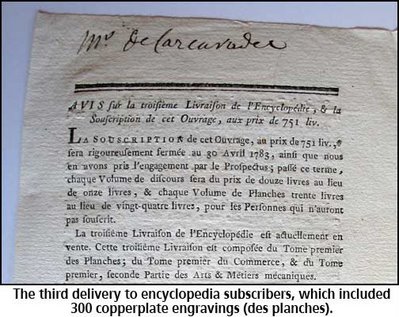
Update on the library catalog: I have now entered into a database most of the Kerivon books printed before 1800. I have been working my way through 150-plus unbound volumes of the Ency- clopédie Méthodique. The EM was the culmination of the Enlightenment effort to systematize and record knowledge in every known discipline. As examples, the EM had 10 volumes (800 double-column pages each) devoted to medicine, 8 to jurisprudence, 5 to modern history, and 4 to architecture. Not all was deadly serious: there was a volume devoted to hunting, and 3 to games.
The EM was sold by subscription. The document pictured here was included with the 3rd delivery of Encyclopedia volumes and has Gerald’s ancestor’s name at the top. The publisher is very eager to assure the subscribers that they are getting their money’s worth. The EM was begun in 1782, but the French Revolution scattered (in some cases liquidated) many authors and subscribers. Finally, in 1832, the daughter-in-law of the original publisher pulled the plug after 200 volumes (!) had been issued. The final volume was part 3 of the natural history of worms. Thousands of copperplate engravings accompanied the EM. Gerald has most of them and they are treasures. They illustrate dozens of trades (carpentry, masonry), industries (a dozen on sugar refining), animals of every type, and even magic tricks. I hope to get a scanner over to Kerivon and capture some of these.
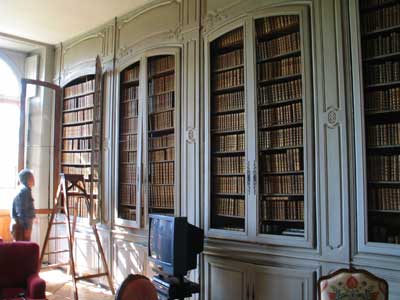

2 Comments:
Another brilliant account of your fascinating travels in France. You make what you see come alive with a few choice words. I chuckled at your description of the French bureaucracy in action, recalling the coughing, sneezing, germ-spewing postal clerk in Lannion who tried to sell me 5 smaller denomination stamps because he didn't have the single one needed for a postcard to the U.S. Vive la France! The flower-decorated graves brought to mind all the Breton church cemeteries we visited with the array of grave-markers. For a nation of non-church-goers, the French devote a lot of time and effort to religious observances! Thanks for continuing to share your adventures.
Good post, Bob. Which posts recount your food and wine adventures?
Post a Comment
<< Home